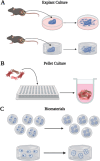Growing Pains: The Need for Engineered Platforms to Study Growth Plate Biology
- PMID: 35905390
- PMCID: PMC9547842
- DOI: 10.1002/adhm.202200471
Growing Pains: The Need for Engineered Platforms to Study Growth Plate Biology
Abstract
Growth plates, or physis, are highly specialized cartilage tissues responsible for longitudinal bone growth in children and adolescents. Chondrocytes that reside in growth plates are organized into three distinct zones essential for proper function. Modeling key features of growth plates may provide an avenue to develop advanced tissue engineering strategies and perspectives for cartilage and bone regenerative medicine applications and a platform to study processes linked to disease progression. In this review, a brief introduction of the growth plates and their role in skeletal development is first provided. Injuries and diseases of the growth plates as well as physiological and pathological mechanisms associated with remodeling and disease progression are discussed. Growth plate biology, namely, its architecture and extracellular matrix organization, resident cell types, and growth factor signaling are then focused. Next, opportunities and challenges for developing 3D biomaterial models to study aspects of growth plate biology and disease in vitro are discussed. Finally, opportunities for increasingly sophisticated in vitro biomaterial models of the growth plate to study spatiotemporal aspects of growth plate remodeling, to investigate multicellular signaling underlying growth plate biology, and to develop platforms that address key roadblocks to in vivo musculoskeletal tissue engineering applications are described.
Keywords: bones; cartilages; growth plates; physis; tissue engineering.
© 2022 The Authors. Advanced Healthcare Materials published by Wiley-VCH GmbH.
Conflict of interest statement
The authors declare no conflict of interest.
Figures




References
-
- Lowe J. S., Anderson P. G., in Stevens & Lowe's Human Histology, 4th ed. (Eds: Lowe J. S., Anderson P. G.), Mosby, Philadelphia, PA: 2015, p. 239.
-
- Hoemann C. D., Lafantaisie‐Favreau C. H., Lascau‐Coman V., Chen G., Guzmán‐Morales J., J. Knee Surg. 2012, 25, 85. - PubMed
-
- a) Oegema T. R. Jr., Carpenter R. J., Hofmeister F., Thompson R. C. Jr., Microsc. Res. Tech. 1997, 37, 324; - PubMed
- b) Gupta S. D., Workman J., Finnilä M. A. J., Saarakkala S., Thambyah A., J. Mech. Behav. Biomed. Mater. 2022, 129, 105158; - PubMed
- c) Mente P. L., Lewis J. L., J. Orthop. Res. 1994, 12, 637. - PubMed
Publication types
MeSH terms
Substances
Grants and funding
LinkOut - more resources
Full Text Sources

